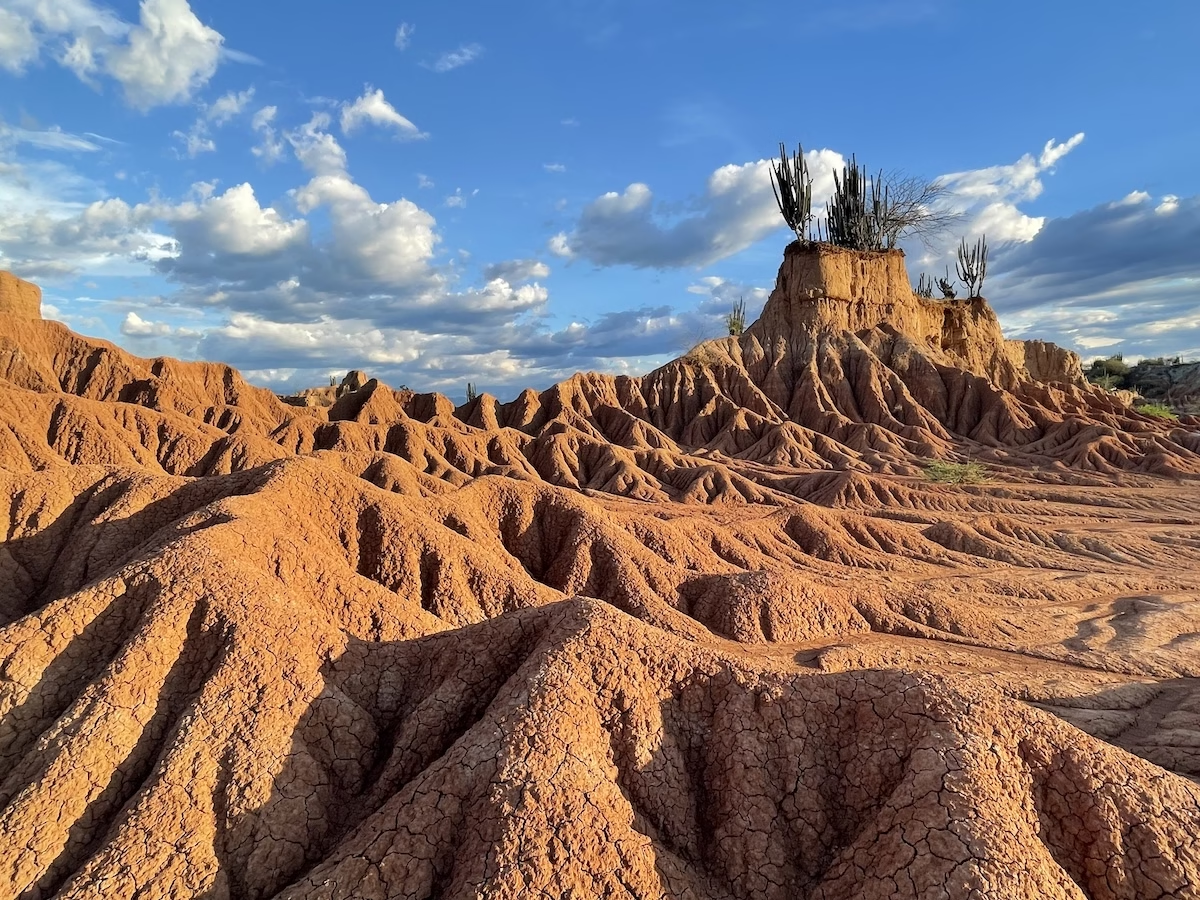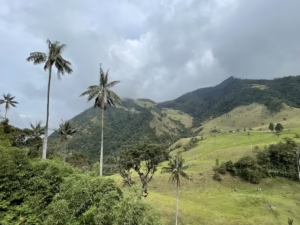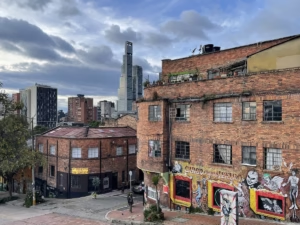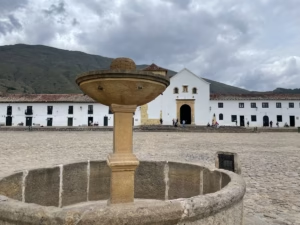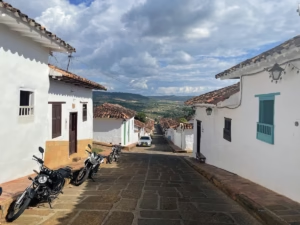The Tatacoa Desert is a place of otherworldly beauty. It’s rugged and romantic and poetic and blisteringly hot. It’s a desert that isn’t really a desert. The Spanish conquistadors who first set sight on this arid landscape called it the “valley of sorrows.” Today, the Tatacoa Desert is a popular tourist destination and one of Colombia’s most astonishing wonders.
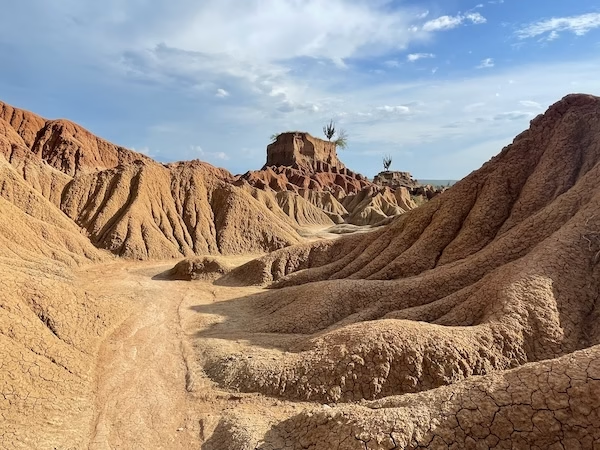
What to Know About the Tatacoa Desert
If you’re starting to research visiting the Tatacoa Desert, you’ve probably already heard the famous line about how it’s not really a desert. The Tatacoa “desert” is technically a tropical dry forest. Apparently, it just isn’t quite dry enough to achieve that coveted desert status.
While this might be technically true, it seems a little nitpicky to me. Like the person who points out that Frankenstein was the name of the scientist and not the monster. When you’re sweating it out under the scorching hot sun in the Tatacoa, it won’t make much difference to you that you’re technically sweating under tropical dry forest heat and not desert heat.
Yes, the Tatacoa desert is very hot. And unlike a proper desert, it doesn’t really cool off much at night. Prepare to get hot and sweaty. I suggest embracing it. Wear light, loose clothing, a wide-brimmed hat and drink plenty of water and electrolytes. Try to avoid being out in the middle of the day if you can help it.
As I said before, the Spanish originally called it “Valle de las Tristezas” or “Valley of Sorrows.” The modern name “tatacoa” comes from an indigenous word meaning “rattlesnake.” Don’t worry, we didn’t come across a single snake.
The Tatacoa desert is split into two parts based on the color of the rocks: the red desert and the grey desert. Both are gorgeous in very different ways. In one you can imagine you’re on mars, on the other you’ll pretend you’re on the moon. Practically speaking, the red desert is much closer to town, while the heart of the grey desert is an almost 45-minute drive.
The rock formations in both the red and grey deserts are mainly made up of clay and sandstone. Years of erosion have carved them into the shapes you see today. However, clay and sandstone are both quite fragile. Be sure to stick to the trails, and be especially sure to not be one of those jerks who climbs the rocks, or worse, carves your name into them.
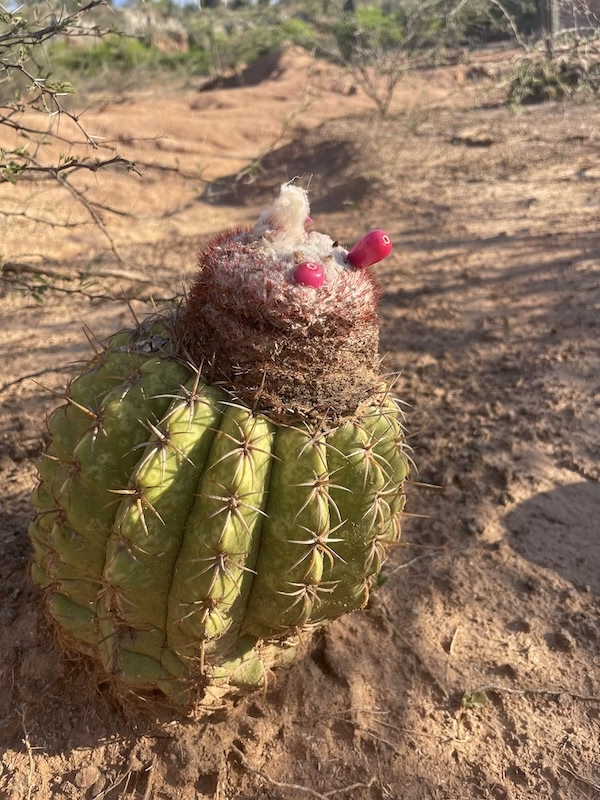
How to Get to the Tatacoa Desert
Considering how often you see the Tatacoa Desert on lists of must-see travel destinations in Colombia, the place is surprisingly a pain to get to. It’s located a long way from the middle of nowhere.
No matter where you come from, you’ll first have to make your way to the town of Neiva. Neiva is about six hours from Bogotá and a whopping twelve and a half hours from Medellín. I believe we came from Armenia, near the Eje Cafetero, which was only supposed to be about 6 hours. I believe there’s a small airport in Neiva, so you could theoretically fly if you’re short on time and have cash to burn.
However, you arrive in Neiva, you’ll have to take another bus to reach the Tatacoa desert. It takes about an hour and a half to reach the small, desert town of Villavieja. Buses from Neiva run to Villavieja regularly, and take about an hour and a half. Villavieja is the gateway to the Tatacoa desert.
This all sounds good, in theory. Unfortunately, our bus from Armenia to Neiva broke down in the middle of the highway. We were stuck waiting it a sort of truck stop on the side of the road for hours before we were able to cram into the next bus. By the time we made it to Neiva, the last Villavieja bus had already left. Luckily, we were able to find a friendly German and split a taxi with him. The drive took about 45 minutes, and while it cost a lot more than the bus, it wasn’t so bad split three ways.
Once you reach Villavieja, you’ll find a small army of tuk tuks waiting around the town square. These are those three-wheeled little vehicles that are popular throughout the developing world, and will be familiar to anyone who’s been to Guatemala or South East Asia. Fares are reasonable, and the drivers can also give you a tour of the desert in addition to bringing you where you need to go.
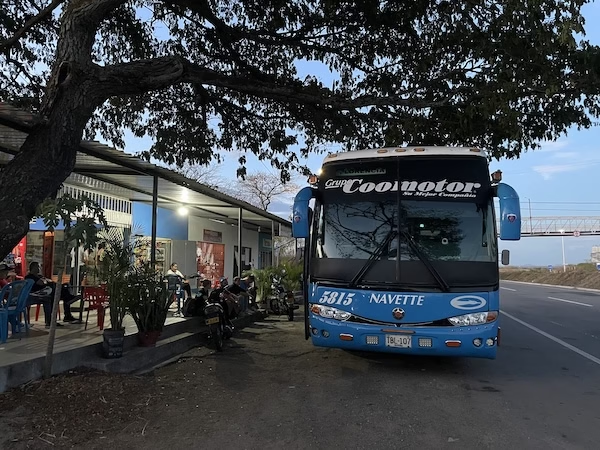
Where to Stay in the Tatacoa Desert
You have two options of where to stay when visiting the Tatacoa Desert. Both options have their advantages and disadvantages. If you’ve got time, I’d suggest doing what my wife and I did and choosing both options.
On one of the most fun, but also most stressful, aspects of travel is finding and booking places to stay. These days you have options ranging from dirt cheap hostel dorms to luxurious White Lotus style resorts. Thankfully, the internet is here to make finding accommodation easier.
Hostelworld is the go to app for finding hostels. For everything else, there’s Booking.com. If you book through either of the previous links, I’ll gain a small commission at no extra cost to you.
Staying in Villavieja
Option one is to stay in Villavieja and rely on the tuk tuks to bring you into the desert for hiking and day trips. The advantage of this option is that your accommodation will probably have air conditioning and maybe a pool. At the very least, you’ll get a much-needed electric fan. Villavieja is a cute town, and you’ll also have more options for dining and whatnot.
The downside is that you’ll likely get to the desert hiking trails later in the day and have to negotiate with the driver to pick you back up and bring you back to town. As I mentioned above, tuk tuk drivers offer a standard tour, but that can be restricting in its own way.
If you do stay in Villavieja, I recommend Hotel Colonial Villavieja. It was a friendly little place with decent accommodations, breakfast included and an on-site restaurant for later meals. They also had a pool, which felt absolutely amazing on hot afternoons. The whole place weirdly reminded me of one of those old-school local motels you might find in some small town along Route 66 in the Southwestern United States.
Click here to book a stay at Hotel Colonial Villavieja and you’ll be supporting this website with a small commission at no cost to you.
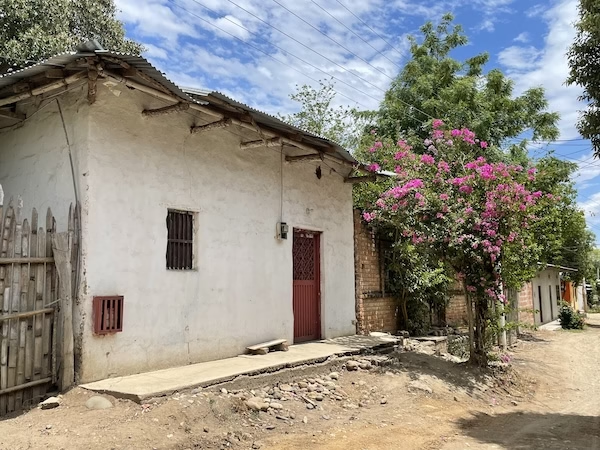
Staying in the Desert
The second option is to stay in the desert. While I liked Villavieja and the Hotel Colonial, staying in the desert was by far my favorite. It was awesome, mainly being out surrounded by the freaking gorgeous desert. You can also start hiking early, avoiding the heat and other tourists. At night, you have the desert to yourself and spend the day surrounded by the incredible landscape of Tatacoa.
The main downside is that you’re far from everything. You have to rely on your accommodation for food, water, and everything else. It’s also very, very hot. You can’t expect luxuries like pools or air conditioning or functioning fans this far out.
For me, however, the tradeoff of comfort for a unique and memorable experience was totally worth it.
Most other travel blogs suggest a particular hostel near the red desert. We met people who stayed there and they said it was fine. However, we decided to go a bit deeper and stay far from everything in the mysterious depths of the grey desert.
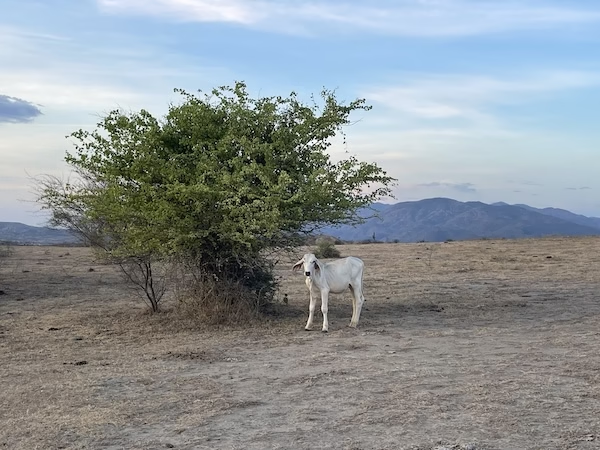
Hospedaje Mirador Valle de la Tatacoa
We stayed at a little place called Mirador Valle de la Tatacoa. It was great. Maybe one of the best places I’ve ever stayed at.
The Mirador Valle de la Tatacoa is a simple collection of rustic wooden cabins out in the desert. Each cabin is solar powered, and there’s a big water tank for the toilet and showers. There’s a sort of dining and seating area which doubles as a simple restaurant down the hill. The food was very good, and they also have plenty of water and beer.
The Mirador Valle de la Tatacoa is also locally owned. A rancher basically decided to take advantage of the tourists and built the cabins and kitchen on the family ranch. He still works most days tending to the herd, and you can watch him bring in the cows from their grazing areas every night. He’s also a super nice guy and willing to help or just chat for a bit in Spanish.
I will say, though, the place is rustic. The cabins are simple. Since everything is solar powered, the fan stops working at night and things get hot. It’s not the sort of place to stay if you’re particular or seeking anything resembling luxury or even comfort.
For the more adventurous, though, I wouldn’t even hesitate. Click here to book a stay at Mirador Valle de la Tatacoa. Again, clicking this link helps support this site.
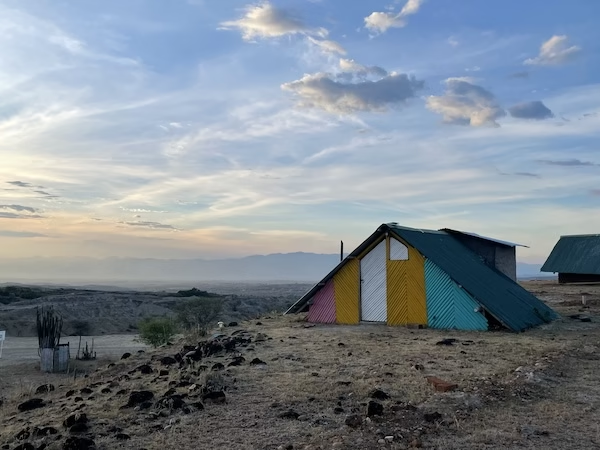
Things to do in the Tatacoa Desert
The Tatacoa Desert is beautiful, but it’s not the sort of place where you’ll want to push yourself. The main draw are the various trails that wind their way through the strange, rugged landscape. None of the trails are particularly long or steep. It was so hot, however, that we ended every day sweaty and exhausted. Sweaty and exhausted, but very happy.
I usually like to travel and do activities independently, but sometimes you want to relax and let someone else take over. For those times, I suggest using Get Your Guide. Prices are reasonable and they have numerous tours available. Click here to explore options in Colombia. Tours booked through these links help support this blog at no extra cost to you.
Hiking in the Desert
The Tatacoa Desert has a number of hiking trails. As I said, none of them are particularly long, but the heat ups the difficulty level quite a bit. You’ll want to have decent shoes and plenty of sun protection. Don’t forget to drink a lot of water.
If you’re staying in town, you’ll have to take a tuk tuk to the trail heads. If you stay at the Hospedaje Mirador Valle de la Tatacoa, you’ll be right near the trails for the grey desert. You will, however, need a ride to the red desert.
The hiking trails are fairly easy to follow, but not very well marked. It’s easy to lose the trail and find yourself on a goat path or dried up riverbed. Thankfully, the landscape is varied enough that we had no trouble finding our way back if we got lost. Don’t count on cell service, so make sure you’ve downloaded any maps you might need in advance.
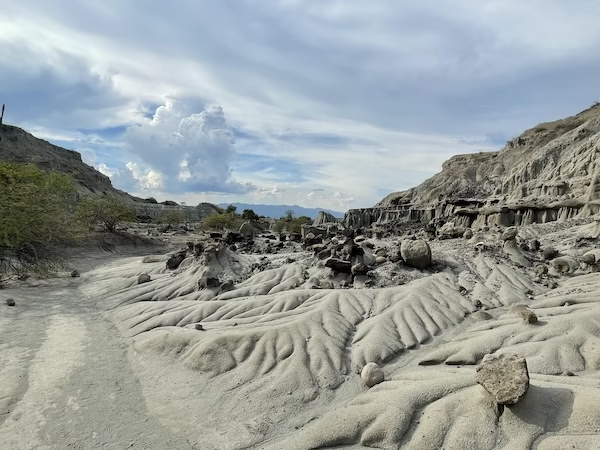
The Cusco Labyrinth
The Cusco Labyrinth trail is the main, and only, hiking trail in the red desert. The trail head is just across from the astronomical observatory. You’ll also find a restaurant, and I believe that popular hostel is nearby, too. If you’ve visited the South Western United States, you’ll find the red rocks and cacti familiar. This is also probably the Tatacoa Desert at its most photogenic.
There are two loops you can take, a long loop which is about two and a half miles (four kilometers) and a shorter one mile (1.6 km) long loop. Both pass by some very stunning scenery. As much as I suggest starting early to avoid the heat, this spot is particularly beautiful in the late afternoon golden hour light. The mirador (viewpoint) near the trail head is an especially good spot to catch the sunset.
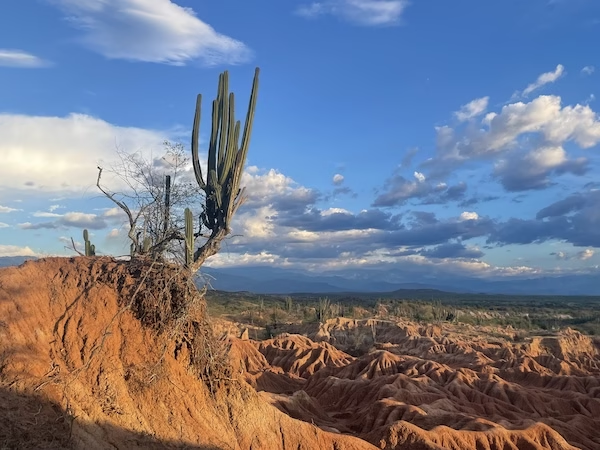
Los Hoyos
The Los Hoyos trail is in the grey desert. This short loop passes by some of the most fantastical and otherworldly scenery in the Tatacoa Desert. The rocks have a grey, lunar quality. You’ll find formations that look like mushrooms, H.R. Geiger-style nightmares and even some that looked, to me, like little kids in Halloween ghost costumes. This area is called the “valle de las fantastmas” or the valley of ghosts.
Nearby you’ll find a small restaurant, as well as some natural swimming pools. The restaurant was closed when we visited, and we didn’t bring our swimsuits to try the pools. They looked nice, though.
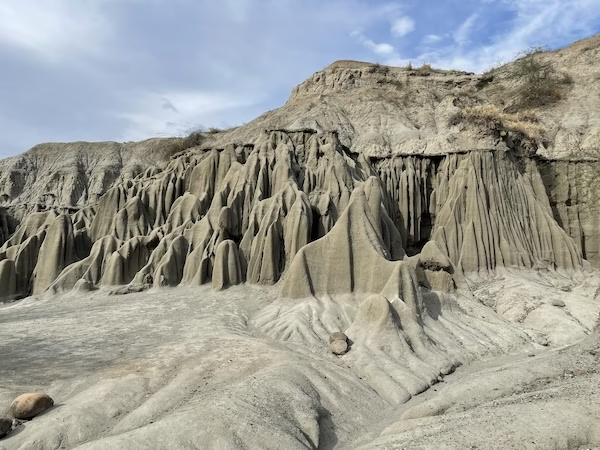
Xilópalos Valley
The last major trail is the Xilópalos Valley trail, which is located deep within the grey desert. While the rock formations here aren’t quite as fanciful as Los Hoyos or the valley of ghosts, it’s still quite pretty. The trail cuts through ravines and gullies, and the surroundings are reminiscent of what you might see near the Badlands of South Dakota.
We also saw a little bit more wildlife in this section. Mostly birds, including a family of adorable ground owls. The trail is just a little over a two-and-a-half-mile loop. You can find the trail head just across from Hospedaje Mirador Valle de la Tatacoa, which also is the only place around where you can get food or drinks.
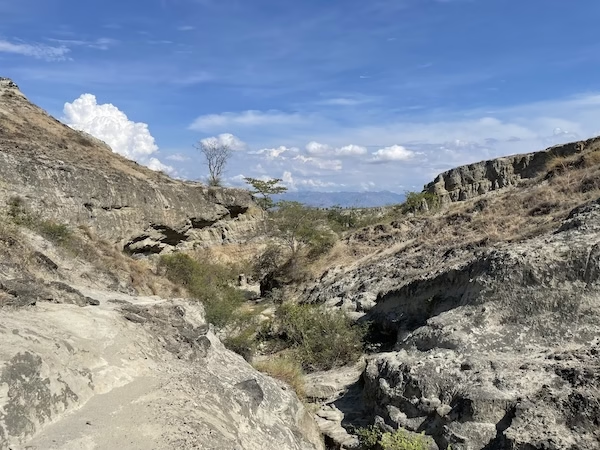
Go Stargazing
Despite not technically being a real desert, the Tatacoa Desert has incredibly clear night skies. It’s a great place to go stargazing. So, I’m told, anyway.
We happened to be there during a full moon. The moon was so bright it blotted any chance we might have of seeing stars. Sitting in the moonlight in the middle of the desert was, however, pretty romantic. But I imagine seeing stars would’ve been nice.
If things aren’t too cloudy or too moony, you could also visit the local astronomical observatory. The observatory is located just across the road from the Cusco Labyrinth trail. You can try their Facebook page for more information: https://www.facebook.com/oatastrotatacoa
Explore Villavieja
Villavieja is the gateway to the Tatacoa Desert. While the desert itself is the main draw, it’d be a mistake to just view Villavieja as nothing more than a jumping off point. If you dare to stick around a bit, you’ll find a charming little town full of rustic adobe houses, dirt roads and a slow pace of life reminiscent of other lost-in-time Colombian towns, like Mompox. I liked Villavieja.
The town can’t match the picturesque colonial architecture of some of Colombia’s other magical small towns, it still has its own scruffy sort of charm. There are plenty of old colonial style adobe buildings and it’s welcoming without being touristy. There are also some incongruous sculptures of prehistoric sloths and goats to check out.
While you should definitely prioritize the Tatacoa Desert itself, Villavieja is worth a few hours of exploration on its own.
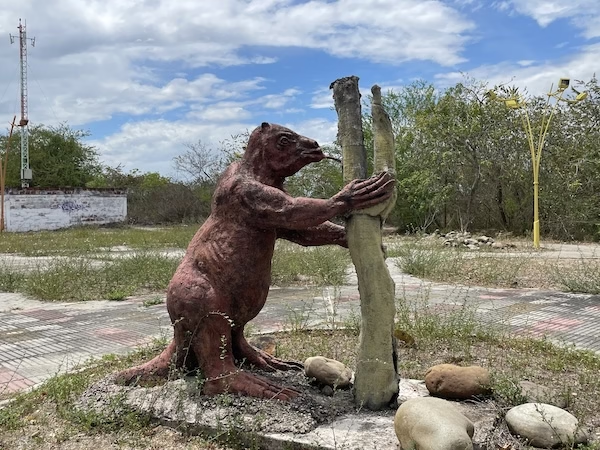
Final Thoughts on Tatacoa
The Tatacoa Desert is one of those places that doesn’t feel like anywhere else. The scenery might be reminiscent of Arizona or New Mexico, but there’s also something inescapably Colombian about it. At the same time, it feels like nowhere else in Colombia. It’s one of those places with a sort of magical feeling that you can never quite put your finger on.
The desert does have its own impressive sights. Some of those rock formations are absolutely fantastical. Sometimes it feels like you’re wandering through a real-life Dr. Seuss illustration made of rocks. Other times, when you’re watching the red light of the sun sink below the horizon, you might feel like you’ve landed on mars.
But the Tatacoa desert also has plenty of little moments that add to the magic. Things like tasting the local cactus fruit, or finding the soft footprint of a small wildcat in the dry desert mud. Or staying up late drinking a beer with your partner surrounded by the silvery light of a full moon.
The Tatacoa Desert is not a comfortable place. It’s hot, and dusty and lacking plenty of modern comforts. I’m sure those early Spanish conquistadors had a good reason to call it the “valley or sorrows.” However, if you’re willing to deal with some discomfort, you’ll find enough big beautiful views and magical little moments to make travel to the Tatacoa Desert a truly wonderful experience. Maybe those conquistadors were just too focused on gold and domination to notice those magical little moments.
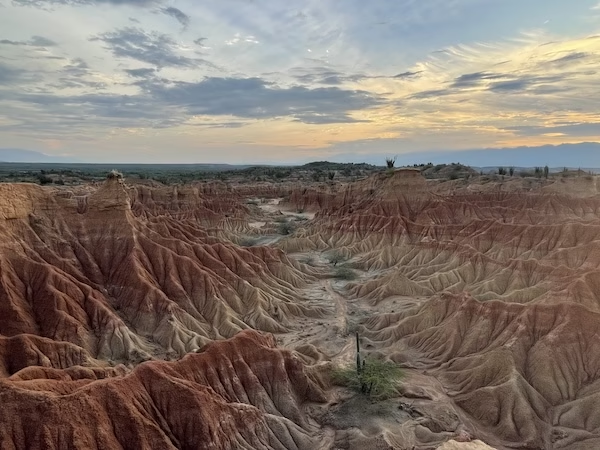
Planning a bigger Colombian adventure? Visit our country guide here: Covering Ground in Colombia: A Travel Guide to One of the World’s Most Magical Countries

